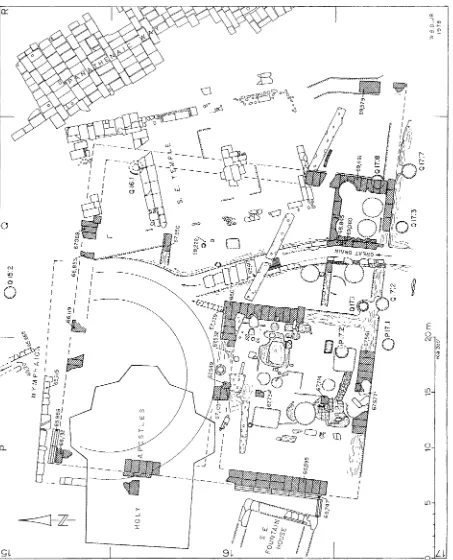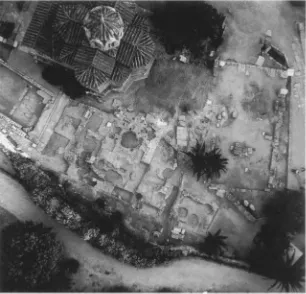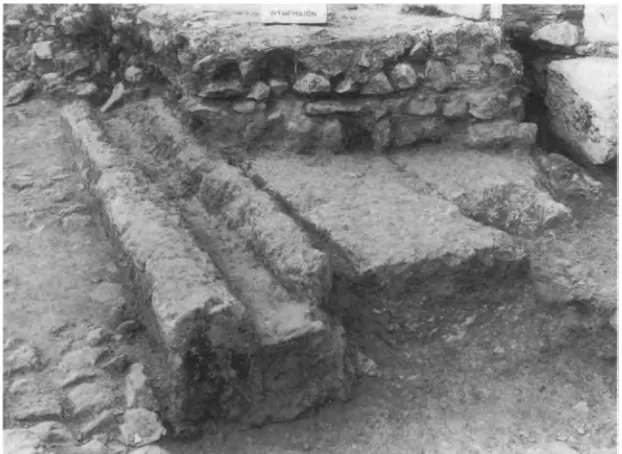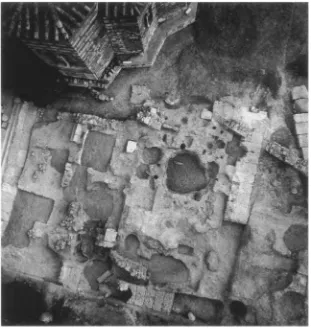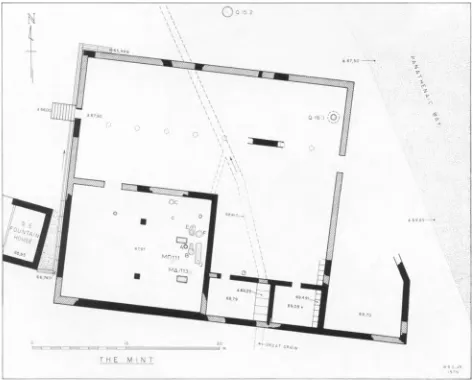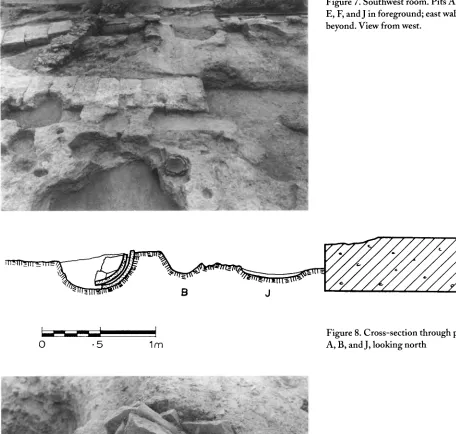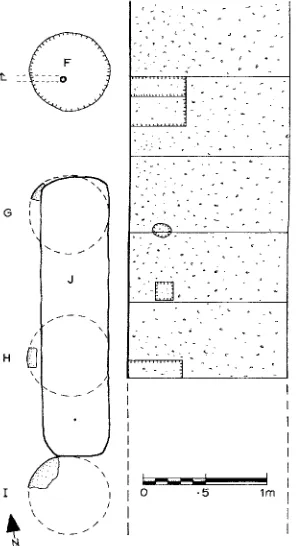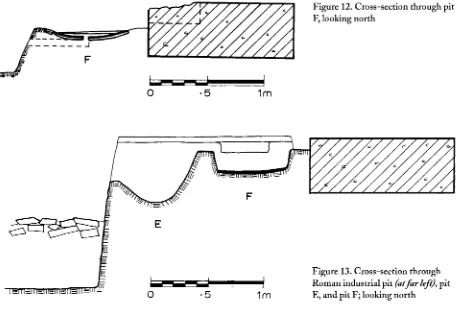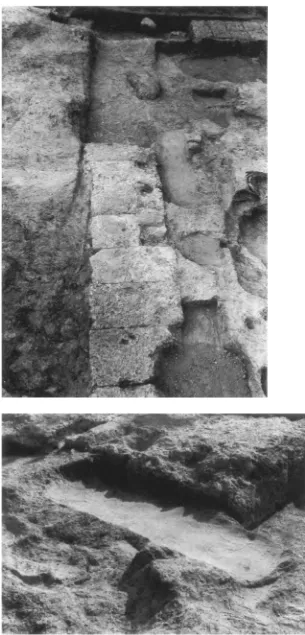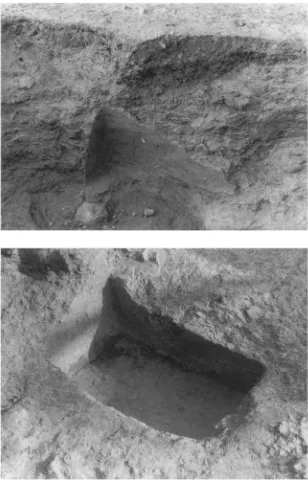Pagesi27-162 AN ATH ENIAN
RO
n
1
ZE
COINI
1AGE
ABSTRACT
The large square building in the southeast corner of the Athenian Agora, excavated in the 1950s and in 1978, served as the Athenian mint for the strik- ing of bronze coins from the 4th through the late 1st century B.C. The best- preserved part ofthe building, the southwest room, produced ample evidence ofindustrial activity, including unstruck bronze coin blanks and rod segments from which the blanks had been chopped. The building was constructed near the end of the 5th or at the start of the 4th century B.C., but whether it was originally intended for the coining of bronze is uncertain.
In 1952 and 1953 a large square building of Classical date was found at the southeast corner of the Agora square (Figs. 1 and 2); further excava- tions were carried out in 1959 and 1978. Though poorly preserved, the building has been identified as a mint on the basis of large amounts of industrial debris found in the area, together with numerous unstruck bronze coin blanks, or flans.1 We present here an account of the surviving remains and related small finds, the results of metallurgical analyses of a selection of the blanks and of Athenian bronze coins, and consideration of the role of the building in the history of Athenian coinage.
THE BUILDING AND THE EXCAVATIONS
OF 1978
THE SITE
The building lies immediately west of the Panathenaic Way and east of the Archaic Southeast Fountain House. For most of its extent, it rests directly on bedrock that slopes down relatively steeply toward both the west and north. Floor levels were not preserved throughout most of the building, but the lowest course of foundations lies some 3.35 meters lower at the northwest corner than at the southeast corner. Bedrock within the building rises as high as 67.82 masl in the southwest quadrant, 68.60 in
1. The site was first excavated by M. Crosby in 1952, with preliminary notices published in H. A. Thompson 1953, p. 29, and H. A. Thompson 1954, pp. 45-48. Further work was done by D. B. Thompson in 1959, with the results published in H. A. Thompson 1960, pp. 343-344. Additional work done in 1978 was published in Camp 1978 and Camp 1979. More synthetic accounts appear in Camp 1986, pp. 120-135, and Camp 1990, pp. 162- 163. See also J. Kroll inAgora XXVI, pp. 292-295. In the present study both
authors collaborated, J. Camp being
largely responsible for the report of the building and the excavations of 1978 and J. Kroll for the report of the unfinished coin blanks and associated bronze debris. We are indebted to the
Agora photographer, Craig Mauzy, for
new photographs, to Anne Hooton for inking the drawings, to the Solow Art and Architecture Foundation for assisting the final stages of Kroll's contribution with a summer research fellowship, and to the anonymous readers of the manuscript for some very helpful recommendations.
American School of Classical Studies at Athens is collaborating with JSTOR to digitize, preserve, and extend access to Hesperia
_66,853 167068
0~~~~~~~~~~
6773
5 10 15 20 m'NBD.,JR5|
L 0~~~~~~~~~~~~~~~~~~~~~~~~
7,1(03 5 312
~
~
~
~
Qj3Q0 5 01 0 .DR
I , * , . I I l ~~~~~~~~rca 2ool ' 9786
Figure 2. Agora Mint. Church of the Holy Apostles at upper left, founda- tions of Southeast Temple at upper right. Aerial view, 1979.
the central room along the south, and 69.00 masi in the southeast room, where it appears to have been dressed down. The limited depth of fill has contributed to the poor state of preservation of the building; later kilns and casting pits, a lime-slaking pit, and cuttings for pithoi go deep into bedrock at various places.
There are no traces of an immediate predecessor on the site. A few very short stretches of rubble walls and several wells in the vicinity suggest that there were modest private houses in the area until the middle years of the 6th century B.C. The first obviously public building is the Southeast
Fountain House, which should be dated to the years around 530-520 B.C., lying just west of our building, with its floor level some 1. 80 m lower than the level of bedrock in the southwest quadrant of the Mint.
A narrow space was left between the two buildings; as the fountain house is set on a more northeasterly orientation than the Mint, the space is wedge-shaped, with the narrow end opening toward the north. This area was paved with poros slabs, and a well-cut open gutter made of poros blocks was laid running along its south side from the southeast corner of the fountain house to the southwest corner of the Mint, at which point it turned north and ran along the entire length of the Mint's west wall. At the northwest corner of the Mint, it turned east and continued at least partway along the north wall (Fig. 3). It is not clear whether this gutter was designed simply to carry off drainage water, but its origin at the corner wa'terc channel-which p1robably-- %, ran wirth-i tesut n as al ofn the4-N
fonanhuet_nueacniuu floofwtrithguerhn
11 t 4 8 M I '
~~~~~~~~
H A I O N -Figure 3. Agora Mint, northwest corner with poros water channel; mortared rubble masonry of the
phaion, above. View from northwest.
Figure 4. Agora Mint, west wall under the western apse of the Church of the Holy Apostles. View from south.
The level of the poros paving is intermediate between the floor levels of the two buildings, lying some 0.64 m above that of the fountain house and ca. 1.17 m below the level of bedrock in the southwest quadrant of the Mint. At some point the paving was covered with a thick layer of water- proof cement made of small rounded pebbles set in a hard white mortar. This layer, together with its packing, is ca. 0.16 m thick, bringing the floor level flush with the rim of the poros gutter. The poros slabs and cement floor could represent two distinct building phases, though they might equally well be regarded as part of a single operation.
DESCRIPTION OF THE REMAINS
The building itself is in a poor state of preservation, with the wall blocks extensively robbed out, and only the partially preserved lowest course of foundations gives some idea of the plan. The northern half, in particular, has suffered; here, the northeast corner was overlaid by the Southeast Temple in the early 2nd century A.C., while the northwest corner was first
covered by the hemicycle of a huge nymphaion, also of the 2nd century
A.C., and then by the Church of the Holy Apostles in ca. A.D. 1000
(Fig. 4).2 The foundations are of well-cut squared blocks of easily worked, light poros (L. 1.20-1.30, W. 0.60-0.65, H. 0.48 m; i.e., 4 by 2 by 1.5 ancient feet). For the most part they are laid as headers, though for at least part of the length of the west wall they were set as a double row of stretch- ers. The overall dimensions of the building correspond nearly to a square, measuring 27.20 m north-south and 28.90 m east-west. In addition, the irregular area between the east wall and the Panathenaic Way was at least partially enclosed by walls at the south and east.
Of the interior arrangements, only those of the south half of the build- ing may be restored with any degree of confidence. In the southwest quad- rant there was a large room measuring ca. 14.00 m east-west by 11.00 m north-south (Fig. 5). Near the midpoint of the room, on its east-west line, two poros blocks remain in situ in an appropriate position to have carried interior supports. The southern block was moved when it was incorpo- rated into a Roman wall, though it should lie close to its original position. To the east, in the southeast quadrant of the building, there are two smaller rooms set side by side along the south wall. The western room measures ca. 5.00 m east-west by 3.90 m north-south; the eastern room measures ca. 4.20 m east-west by 3.90 m north-south. In the western room, the eastern parts of the west foundations are made up of irregular blocks of Acropolis limestone, the only use of a material other than poros in the surviving foundations.
To the north of these three southern rooms only a few blocks survive of the west and north walls of the building. Two poros blocks lying just outside the western wall (Figs. 4 and 6) perhaps indicate the position of an entrance on that side. Within the northeast quadrant a single poros block remains in situ, oriented east-west and lying about 6 m from the line of both the east and north walls. It may well be that a large part of the north- ern half of the building was an open-air courtyard, perhaps with a light colonnade, but not enough survives to allow more than this tentative suggestion.
2. For the date of the Southeast Temple: Dinsmoor 1982, pp. 431-433;
for the Nymphaion: Agora XIV,
Figure 5. Balloon view of Agora Mint, southwest room
In addition to the poros gutter along the outside of the west and north walls, several other hydraulic installations in the immediate area should be noted. The east branch of the so-called Great Drain passed under the building: on the south, it ran under the east side of the central room, where the drain and room shared a common eastern wall, and just north of the north wall of the room, it turned to a northwesterly orientation and passed through and outside of the north half of the building. Not enough survives in this area to show what channels of the Mint, if any, may have emptied into the large drain. A well (Q 15:2) some 6 m north of the building, west of the Panathenaic Way and within the open square of the Agora, might be associated with the Mint in some way. The Mint is the building closest to the well, which should presumably be thought of as a public well, and a huge mass of material was thrown into the shaft when the well went out of use apparently at the end of the 5th century B.C., just as or soon after the Mint was built. Finally, within the northeast quadrant of the Mint was excavated a bottle-shaped Hellenistic cistern (Q_16:1), in use in the 3rd
century B.C.3
cetryBC
3. Only a handful of pottery (lot HA 168) and three catalogued objects (basin: P 26660, casserole: P26661, and a storage jar: P26662) were recovered
from the cistern; they provide no useful information about the use of the
building. For well Q-15:2, see Agora
67,50~~~~~~~ I 66'\\,0o2f
t~~~~~~~~~~~~~~ \' :
j~~~~~~~~~~~~~~~~~~~~~
1X
_
_?-
-I
Oc
1,' DS~~~~~~~~~~~~~
* ?~~~~~~~~~~~~~~~~~~~~~~~~~~~~L69 65-
SE , , E _ 0 9 7 AI)N 20 2 0 G 9 E A T 0 R
TH E M IN T
Figure 6. Agora Mint, restored plan.
AfteradrawingbyW.B.DinsmoorJr., SOUTHWEST ROOM: INDUSTRIAL (Figs. 5 and 7)
1979~
~ ~
~~~~~~~~~~~8796.91979 IN STALLATION S
The large southwest room is the best-preserved part of the building and here were found installations and small finds which lead to the identifica- tion of the building as a mint. In all, ten pits and two water basins were uncovered in the eastern part of the room, where the latest floor levels were preserved, along with lumps of bronze and slag together with some ash and flecks of carbon. Here, too, were found dozens of coin blanks, scattered throughout the fill and in the pits.
The pits seem to break down into three distinct types; in general, they seem also to represent a distinct chronological sequence. The features of each group may be characterized as follows:
GROUP 1 (PITS A-E) (Figs. 7-9)
Figure 7. Southwest room. Pits A, B, E, F, andJ in foreground; east wall
beyond. View from west.
'v'::t'-~ -4ii|II_X -
I I Figure 8. Cross-section through pits
0''5
im
A, B, andJ, looking northFigure 9. Pit A, detail of basins
ibS iZ ffi | 111 _
~
~~~P312adP110,sfunisurfaces displaying ample signs of burning. Pit A had two basins preserved in situ, one nestled within the other (P 31129, P 31130). Pits B and C had
g
F A large fragments of similar basins in their fill, though not in situ. Another - < > O > t
distinguishing feature is the date of the material in the fill of these pits, which suggests a terminus ante quem in the early 3rd century B.C. Pit D, ; which had no fragments of basins, went out of use at this time.4
GROUP 2 (PITs F-I) (Figs. 10-13)
G a .; '- -
/ P ^ - - v Only one pit of this type was fully preserved. It was shallow, 0.65 m in
diameter, and was lined at the bottom with red clay or mudbrick. Above were three very thin packed floor levels (ca. 0.008-0.01 m thick) made up of fine, flakey, grayish-brown silt. Cut through the bedrock at the bottom,
-
\ : and covered by the top two floor surfaces, was a hole ca. 0.05 m in diam-
H eter that led to a horizontal channel cut through bedrock, measuring 0.10
\
-' m high and 0.08 m across, its top the original red clay floor of the pit. It
ran westward from under pit F toward the south end of pit E. Pottery
X associated with pit F was generally nondescript and not readily datable.5
I0 im f A, _
Figure 10. Southwest room. Plan showing the east wall (at right); pits F and J, traces of pits G, H, and I (at
left).
Figure 1 1. Pit F, detail of hole
(at center) and channel (at right).
View from northwest.
4. Pottery lots: A = VA 284, B = rIA 285 and 286, C = rIA 287, D = VIA 283,
and E = HIA 281. The pits were given
numbers as excavated; the correspondence
of the notebook designations with the
letters used here is as follows: pit A = 5,
pit B = 6, pit C = 7, pit D = 4, pitE =E2, pit F = 1, and pitJ = 3. S. I. Rotroff and
J. Hayes kindly provided expertise in
dating the Hellenistic and Roman pottery.
5. Pottery lot VIA 280. Generally
nondescript pottery with fragments of a casserole.
Three more pits (G, H, and I; Figs. 10 and 14) attributed to this same series were largely overlaid by pit J of the next group and were put out of use by it. Their western edges could be made out projecting beyond the limits ofJ. As restored, they align with pit F in a north-south line, ca. 0.50 m apart, some 0.15 m from the foundations of the east wall of the south- west room. From their position and apparent similarity it seems likely that they are contemporary with pit F.
GROUP 3 (PIT
J)
(Figs. 14 and 15)Figure 12. Cross-section through pit F, looking north
0 *5 1m
m X
F
E
|= Figure 13. Cross-section through
JI _ b I | Roman industrial pit (atfar left), pit
-~_M:al - - - 0 .5 1 m E, and pit F; looking north
elongated rectangle with rounded corners, measuring ca. 0.55 m wide by 2.30 m long, set in a north-south orientation along the east wall of the room. The flooring was reported to consist of numerous very thin, com- pacted layers of clay and ash with an admixture of corroded bronze, mea- suring altogether some 0.025-0.04 m in thickness. Pottery from levels as- sociated with pit J suggests that it went out of use in the late 3rd/early 2nd century B.c.6 As noted, it overlies pits G, H, and I and therefore postdates them, as well as-perhaps though not certainly-pit F.
It is assumed that these pits, with their evidence of burning and their green discoloration, were somehow used in the processing of metal, pri- marily bronze if we may judge both from the actual material found as well as analysis of numerous samples taken from in and around the pits. At first glance, some of the pits might seem to represent the bases of furnaces or ovens used in some way in the preparation of the bronze. The analysis of the minute layers making up the successive floors of pit J, however, re- vealed no evidence of pyrotechnology, and if there were furnaces in the building, they must be sought elsewhere. The floors of pit J, on analysis, prove to have been built up of successive layers of plaster rather than clay.7
A series of shallow cuttings set into the foundations of the east wall may well have supported additional equipment or some superstructure over the pits (Figs. 7, 10, and 14). Opposite the southern half of pit F there is a rectangular cutting in the east wall measuring 0.45 m east-west by 0.40 m north-south. The southern 0.24 m is 0.05 m deep, while the northern 0.16 m is 0.18 m deep. Part of a similar rectangular cutting lies 1.97 m to
6. Pottery lot HA 282. Coarsewares with fragments of a large basin.
7. Eleven separate layers of pit J were recognized, ranging in thickness from 0.9 to 3.7 mm. The analysis was carried out in 1997 by Roger Doonan, formerly of the Fitch Laboratory of the British School of Archaeology in Athens. No analysis was performed on
the "furnaces" reported from the
excavations in the 1950s (Thompson 1954, p. 46); it may well be that the
original excavators found pits similar to
these and assumed, as did Camp initially, that they were evidence of
pyrotechnology. The thin layers of pit J
Figure 14. Southwest room. East wall, pits F and J at right. View from north.
Figure 15. PitJ View from southwest.
the south, opposite the southern half of pit H. It measures 0.44 m east- west and the preserved north-south dimension is 0.14 m; the adjoining block to the south, which would have carried the south half of the cutting, is missing. The depth of the cutting is 0.17 m. Two smaller cuttings sur- vive between these two, opposite the north half of pit J. The southern of the two is rectangular, measuring 0.14 m east-west by 0.15 m north-south, its western edge set in some 0.22 m from the edge of the foundations. It is 0.14 m deep. The fourth cutting lies ca. 0.45 m to the north, in an area where the foundations are somewhat battered. As preserved, it is rounded or oval, measuring 0.16 m by 0.12 m, and is 0.18 m deep. It is set ca. 0.19 m from the edge of the foundations.
Figure 16. Southwest room, remains of northern plaster-lined basin. View from northwest.
|~~~~~~~~~~~~~~~~~~~-' _l I- C,
_l~~~~~~~~~~~~~~~~~~~Fgr 7 Sotws rom sou|th
As well as these three series of pits and the cuttings apparently used for industrial activity there were also two water basins built within the southwest room which take the form of rectangular pits cut into bedrock, their bottoms and sides coated with a layer of waterproof cement. The northern one was largely destroyed by a later casting pit and only the south- east corner is preserved, its eastern edge lying some 1.90 m from the east- ern foundations of the room (Fig. 16). The southern basin, measuring 1.10 m long by 0.60 m wide and at least 0.80 m deep, is set on an east-west orientation, its eastern side lying some 1.33 m from the line of the east wall of the room (Fig. 17).
THE BLANKS, RODS, AND WEIGHTS(?)
FROM THE SOUTHWEST QUADRANT
In addition to these various indications of industrial activity in the 3rd to 1st centuries B.C., the identification of the building as a mint, as noted,
rests primarily on dozens of small bronze objects consisting mainly of unstruck coin blanks, but also pieces of the bronze rods from which the flans were struck, as well as small bronze rectangles which may have been weights. These objects were found around and in most of the pits of all three periods. Pits G and I were not excavated because of their poor state of preservation and relation to pit J. Of the eight remaining pits, all but pits C and D had small bronze objects found in them and/or embedded in their floors. A detailed analysis and catalogue is presented in the second part of this article (see also Table 1); the distribution of these finds is sum- marized below:
Pit A: 21-35 (Fig. 18): 12 blanks, 1 rod, 2 weights(?) Pit B: 36-55 (Fig. 19): 20 blanks
Pit E: 56-60 (not illustrated): 3 blanks, 2 rods(?) Pit F: 61-83 (Fig. 20): 18 blanks, 2 rods, 3 weights(?)
Pit H: 84-102 (Fig. 21): 15 blanks, 2 rods, 2 rod fragments(?) Pit J: 103-127 (Fig. 22): 14 blanks, 5 rods, 4 rod fragments, 2
weights(?)
21 22 23 24 25
26 27 28 29 30
Figure 18. Blanks and other bronze
36 37 38 39 40 41 42
43 44 45 46 47 48 49
50 52 53 54 55
51 Figure 19. Blanks (pit B). Scale 1:1
61 62 63 64 65
66 67 68 69 70
72 73 74
71 75
76 77 78 79 80
81 82 83
Figure 20. Blanks and other bronze
85 86 87 88 89 90 84
92 93 94 95 96 97
91
98 100 102
99 101
Figure 21. Blanks and other bronze
debris (pit H). Scale 1:1
*
*9^^
103 104 105 106 107 108
109 110 111 112 113 114
6
*
0
*11
115 116 117 118 119 120
121 122 123 124 125
-
S
Figure 22. Blanks and other bronze 16127
In addition to these fairly well defined pits, two other distinct groups of flans were found in shallow depressions in bedrock in the same general area:
From grid-square MA/113: 128-148 (Fig. 23): 20 blanks, 1 rod From grid-square MI/lll: 149-161 (Fig. 24): 13 blanks Miscellaneous findspots: 162-169 (Fig. 25): 6 blanks, 2 rods
Thus from 1978 we have a total of 149 blanks, rod fragments, and weights(?),8 all but eight of them from pits or distinct groups. Pottery found with these different deposits suggests that they were being prepared or used in the building throughout most of the Hellenistic period, from the late 4th or early 3rd century into the 2nd century B.C.
CHRONOLOGY AND FUNCTION OF THE BUILDING
The date of the building is based on ceramic evidence from earth brought in to raise the floor level in the southwest corner. Here, fill as deep as 1.00 m was encountered over bedrock, about half representing preexisting fill and half representing construction fill. The two fills are close in date, com- ing down into the last quarter of the 5th century B.C., and we would prob- ably not be far off in dating the construction of the building to the last decade of the century.9
As we have seen from the evidence of the pits in the southwest quad- rant, the building was in use through the Hellenistic period. The upper- most floors are generally not well preserved and the evidence for the date of the abandonment of the building is indirect. The latest preserved un- disturbed floor levels in use would seem to date no earlier than the late 2nd century B.C.10 Three kilns or firing pits seem to represent the earliest activity in the area after the building went out of use and therefore repre- sent a terminus ante quem; they date to the late 1st century-early 2nd century A.C.11 The building was therefore abandoned presumably in the 1st century B.C. or the 1st century A.C. As noted, the northeast part of the building was covered by the so-called Southeast Temple early in the 2nd century A.C. and the northwest corner was overlaid by a large nymphaion of Antonine date.
The identification of the building as a mint seems clear, given the dozens of unstruck flans and other signs of industrial activity. This makes
8. To these may be added those found in 1953 (1-11), 1959 (12-20), nine found in miscellaneous late contexts in the vicinity (170-178), and three more from the Agora excavations, though not near the building (179- 181). These bring the total in the catalogue to 181 pieces, all but three found in or around the building.
9. Pottery lots IIA 293-298. The ceramic material was plentiful; several
thousand sherds were saved, represent-
ing characteristic coarse- and fineware
shapes: lekanai, Chian amphoras,
"Pheidias" mugs, late red-figured
pieces, lamps, askoi, bowls, cooking wares, skyphoi, and lekythoi. Charac-
teristic pieces represented by multiple
examples include all-black Corinthian-
style skyphoi (Agora XII, p. 83, no. 321:
425-400 B.C.), "Pheidias" mugs (Agora
XII, pp. 72-74), saltcellars (Agora XII,
no. 915: 425-400 B.C.), olpai (Agora
XII, no. 273: ca. 400 B.C.), and Type 23
A lamps (Agora IV, no. 216, last quarter
of the 5th century B.C.).
10. Pottery lot IIA 277, with a long-
petaled Megarian bowl (Agora XXII,
pp. 34-37).
11. Pottery lots VIA 289 and 290,
and T 26, with alpha-globule lamps:
128 129 130 131 132 133 134
135 136 137 138 139 140 141
t~
142 143 144 145 146 147
148
Figure 23. Blanks and rod segments
(grid-square MA/113). Scale 1:1
149 150 151 152 153 154 155
156 157 158 159 160 161
Figure 24. Blanks (grid-square
MF/1 1). Scale 1:1
162 163 164 165
Figure 25. Blanks and rod segments
~
it one of the few recognized mints from antiquity, joining only a handful of examples from other sites.'2
Analyses of assorted materials and samples recovered in the building have revealed only the slightest traces of silver.'3 It seems certain that the famous silver coinage of Athens which was a mainstay of the economy from the 6th to 1st centuries B.C. was not struck here. The so-called argyrokopeion, attested in literature and inscriptions, must be sought else- where.'4 What the analyses do show is that most of the material is largely copper, with lesser amounts of iron and tin, and lesser amounts still of lead. It seems likely, therefore, that bronze was the primary commodity being worked in the building, perhaps with some iron. Less certain, how- ever, is how to correlate this information and the history of the building with the recognized development of Athenian bronze coinage. As noted, the initial construction can be dated to the years around 400 B.C., whereas the earliest Athenian bronze coinage is now usually dated no earlier than the middle years of the 4th century B.C."5 Owing to the Athenians' reluc- tance to attach their name and coin types to a coinage of base metal, the earliest regular bronze coinage with the AOE ethnic and Athena/owl types did not appear before the third quarter of the 4th century.16 It was pre- ceded by fourteen separately marked "Eleusinian" bronze issues, which, while inscribed EAEYEI and having the types ofTriptolemos and a piglet, were nevertheless struck by the city of Athens, in all probability at the same mint later used for the AOE bronze. But on current evidence the Eleusinian bronze is unlikely to have begun before the 350s.17
The bronze coinage inscribed ZAAA for Salamis and designed with the sword and shield of Ajax begins earlier, however, and in the most re- cent discussion of it, Martha Taylor has plausibly argued that it too was struck by and presumably in the city of Athens, rather than on the island of Salamis as the ethnic would have one believe.'8 If so, it might have been minted in the Agora Mint. Several specimens come from contexts of the
12. Other recognized mints include
Olbia (Koscjusko-Valjuzinic 1915),
Halieis (Dengate 1975; Boyd and Rudolph 1978, pp. 339 and 347), Pella (Oikonomidou 1993), Nea Paphos (Nikolaou 1972a and 1972b; Nikolaou and M0rkholm 1976, pp. 9-10), and, from the Late Roman period, Thessaloniki (Velenis 1996).
13. Material from the building has been analyzed on various occasions
under assorted procedures. For analyses
of the bronze blanks and rod ends, see pp. 146-157 below. Thirteen samples,
taken fromn not just blanks and bars, but
also slag, the basins in the pits, and the floor of pit J, were analyzed by the late K. Konophagos of the Polytechnic University and H. Badeka, using X-ray
fluorescence, in December of 1978 and
January of 1979. Additional analysis by
R. Doonan of the Fitch Laboratory was
carried out on the floors of pit J in 1997 (above, note 7).
14. For the literary and epigraphical
sources on the argyrokopeion, see Agora
III, pp. 160-161, to which add Agora
inscriptions nos. I 6236 (Hesperia 32,
1962, p. 31, no. 29) and I 7495 (unpublished), both of the 4th century
B.C. As indicated by their generally
different artistic styles, iconography,
administrative markings, and circula-
tion, Athens' silver and bronze coinages routinely were administered and struck independently of one another (see
Agora XXVI, p. 14, note 46; p. 15; and p. 31, note 38); it is not surprising that they were minted in separate places. The possibility that early Athenian silver coinage was struck in south Attica, near the sources of silver, has been raised by the recent publication of what might be a Late Archaic
bronze die from Sounion (Kalligas 1997). The dies for Athenian gold
coinage of 406 B.C. were dedicated on
the Acropolis (Harris 1995, p. 119, no. 34).
15. This despite an emergency issue
of bronze-plated coinage in 406/5 B.C.:
Ar., Ran. 725-726, with scholia, and Ekkl. 815-822; also references
to kollyboi (Tod 1945), which some
scholars have identified with small bronze tokens. For recent discussions
of the kollyboi and the 4th-century
date for the earliest official Athenian bronze issues, see Agora XXVI, pp. 24- 27.
16. Agora XXVI, pp. 30-31. 17. Agora XXVI, pp. 27-30, and, for the striking in the same mint as the Athena/owl bronze, p. 32.
early 4th century and perhaps the late 5th century, implying that the coin- age began around 400 B.C.,19 in which case it becomes tempting to associ- ate the construction of the Mint with the inauguration of this earliest conventional Attic bronze coinage. This presents an alternative to the ear- lier suggestion that the building was constructed for the manufacture of public weights, tokens, and measures and only subsequently employed for the minting of bronze coins.20
Since the ceramic evidence allows that the Mint could have been con- structed as early as the 410s, and since one cannot rule out the possibil- ity-despite the absence of silver-working evidence from the remaining, essentially Hellenistic, floors, furnishings, and debris of the building- that the structure might have been intended or was used originally for the coining of silver, two further hypotheses deserve mention, both of which would give a date of ca. 414 B.C. for the building of a new mint. This was when the Spartans occupied Dekeleia, endangering Athens' control of the countryside; if the city had been refining or minting silver at Sounion (see note 14 above) or elsewhere in the mining distinct, it would presumably have had to move all such operations into the city at this time. Or, should the problematic "Standards Decree" prove to date as late as ca. 414 or shortly before,21 the construction of a new mint would have been appro- priate for the massive recoining of silver that the decree envisaged. On either scenario, however, it is doubtful that much silver would have been coined after 414, since the silver mines themselves had to be abandoned at that time, and the decree, if so late in date, could hardly have been put into effect after Athens' catastrophic losses at Syracuse in 413. Athens herself stopped minting silver at or before the end of the Peloponnesian War. Shut down by 404, the Mint would have been reopened in the next cen- tury for the coining of bronze.
So far as the date of construction and original purpose of the structure are concerned, therefore, we can offer theories but no answers. There are simply too many unknowns, even, in our view, for favoring any one of these solutions over the others. Fortunately for the rest of the building's long history, the evidence to which we now turn is more than sufficient to show that it served as the mint for Athens' bronze coinages of the 4th through 1st centuries B.C.
19. To the three specimens cited in Agora XXVI, p. 215, with contexts of the late 5th or early 4th centuries, a fourth specimen should be added. Coming from a context in the Kera-
meikos dating to 400 B.C., it will be
published in U. Knigge's final report from the Bau Z excavations. Since
these finds aRlow that the coinage could
have begun slightly before 400, they raise the question of whether the bronze coins referred to in Ar., Ran. 725-726 and Ekkl. 815-822 might in fact be Salaminian bronze coins and not subaerate replications of conven- tional Athenian silver coins, as is usually assumed (Kroll 1976 and
1996b; Agora XXVI, pp. 7-8, 25 [where
the Salaminian interpretation is raised
but rejected, perhaps too summarily]). 20. Camp 1986, pp. 129-130. Many of these weights, tokens, and measures carried stamps and/or inscriptions indicating their public nature. We have no information as to how and where these items were produced, whether by the state or private individuals, but some measure of official control over their production and validation must
have been necessary. Two cylindrical
dry measures of bronze, one inscribed
as "public" (demosion), were found in
well Q_15:2, just north of the Mint (B
1082 and B 1082bis = Agora X, DM 42
and 43, p. 52, pl. 14). The Athenians did not employ stamped bronze
allotment plates until after 388 B.C.,
probably in the early 370s (Kroll 1972, pp. 4-7, 87-90).
21. Figueira (1998, pp. 431-465) presents a lengthy review of the chronological evidence and favors a date in the early 440s. But an increas- ing number of scholars have been returning to the more traditional dating in the twenties or teens; see, e.g.,
Fornara and Samons 1991, pp. 98-102;
THE UNFINISHED COIN BLANKS AND ASSOCIATED BRONZE DEBRIS
The notable group of ten unstruck coin blanks and the short length of a bronze rod from which they had been chopped (1-11; see Fig. 26, below, and Table 1) came to light during the second season of excavation of the building, in 1953. Since then the total of coin blanks, rod ends, and related bronze scrap from within the Mint has risen to 169 pieces, 149 of them recovered during the final exploration of the floors in 1978. Find contexts and comparison of the blanks with Athenian bronze coins by weight and alloy indicate that the blanks range in date from the late 4th or early 3rd century to the end of Athens' Hellenistic bronze coinage in the late 1st century B.C.
The composition of the blanks' alloys has proved to be an especially useful chronological index. As shown in Table 2, which lists all Athenian bronze coins that have been metallurgically analyzed, the percentages of tin and lead in the coin alloys display a pronounced shift over time. In the alloys of the 4th- and 3rd-century bronze coinage (Agora XXVI: Peri- ods I and II) the levels of tin are relatively high, roughly in the range of 8 to 12 percent, while the percentages of lead, between 0 and 3 or 4 percent, are extremely modest. In the late bronze coinage of the second half of the 1st century (Periods IVB-E), however, the pattern is reversed: the alloy was cheapened, and softened for ease of striking, with a heavy admixture of lead, normally falling in the range of 10 to 20 percent, at the same time that the tin percentages decline well below their former levels. The analy- ses collated in Table 2 caution that one cannot expect exact metallurgical consistency within a given period or coin variety: a given coinage would have been minted from numerous batches of alloy, which are likely to dif- fer among themselves to some measurable degree (see Table 2, variety 153, with its five analyzed specimens). In the case of some lst-century B.C.
coinages partially overstruck on earlier, obsolete coins that had been with- drawn from circulation, the inclusion of such blanks of older alloy would have produced even greater discrepancies, apparently explaining, for ex- ample, the extremely low lead content of two of the three analyzed speci- mens of the concluding Augustan coin varieties 157 and 158. Making allowances for such anomalies, however, the overall deduction neverthe- less holds that Athenian coins and coin blanks with a high lead content characteristically belong to the last decades of the 1st century B.C. and later.22
One of the Agora blanks was chemically analyzed, soon after its re- covery in 1953, at the Ohio State University.23 The nineteen other blanks whose metallic compositions are recorded in Tables 1 and 3 were analyzed at the Fitch Laboratory at the British School of Archaeology in Athens in
1996, along with twenty-two Athenian bronze coins24 that supplement
the sampling of Athenian coins analyzed by E. R. Caley in the 1930s and by a student of Caley's in the 1950s.25 Altogether, the analyses confirm that the heavily leaded pieces and the rod segment from the 1953 excava-
tions belong to one of the final phases of Athens' Hellenistic coinage of the last half or third of the 1st century B.C. (Periods IVB-E); that the
22. Exceptions are found in Period III, which culminated in the Mith-
radatic star-in-crescent issue of 87/6 B.C.
(variety 97), an emergency issue minted during the Sullan siege of Athens; its softened, heavily leaded alloy is thought to have facilitated striking while
increasing the coins' weight and
acceptability (Agora XXVI, p. 70). It is
unlikely, however, that any such special
historical circumstance will account for
the anomalously high lead content of
two specimens of the fractional varieties
99 and 100, which suggest that the Athenians employed heavily leaded
bronze in the manufacture of minor
denominational coinages before
extending its use to the main, larger
bronze denominations. More analyses
of the Period III coinage are needed, but in the meantime, see the parallel
inconsistency between some large- and
small-denomination blanks (note 28
below).
23. Caley and Deebel 1955. 24. R. Doonan performed the analyses using Inductively Coupled Plasma-Atomic Emission Spectrom- etry, a technique that required drilling a slight turning of 0.2-0.4 g from the edge of each coin (see Hughes, Cowell, and Craddock 1976, pp. 22-26). Full results are reported below in Table 3 and in Doonan's Laboratory Report
on file at the Fitch Laboratory. Besides
Doonan, we have to thank, for their efforts in facilitating the project, I. K. Whitbread, Director of the Fitch
Laboratory; A. Paterakis, Conservator
of the Agora Excavations; and
authorities of the Ephoreia of Classical Antiquities; and, for funding, the University Research Institute of the University of Texas at Austin.
TABLE 1. UNSTRUCK COIN BLANKS AND RELATED BRONZE DEBRIS FROM THE MINTa
EXCAVATED IN 1953
Rod end and 10 chopped blanks found outside the northwest corner of the southwest room, "immediately beneath the latest ancient ground level" (Thompson 1954,46-47, pl. 14:b, photograph reproduced in Lang 1960, fig. 13; Agora XIV, pl. 33:c; Kleiner 1975, fig. 3; Thompson 1976, fig. 78).Agora XXVI, pp. 292-293, pl. 32:d, Group 1. All stripped to bare bronze. Fig. 26
1-11 B 1046 12-14 x 7-10 7.58 g 7.14 6.78 6.78
6.48 (Pb 24.03, Sn 6.50, Cu 67.60) 6.03
5.93 5.10
3.12 fgt. cut on bias
fgt. cut on bias; destructively analyzed in 1954 (Pb 25.63, Sn 7.08, Cu 66.53)
13 x 24 16.95 rod end
EXCAVATED IN 1959
9 pieces, including 7 blanks and 1 rod segment "imbedded in the ancient floor" in the southwest quadrant (Thompson 1960, p. 343). Agora XXVI, p. 293, pl. 32:e, Group 2.b All stripped to bare bronze. Fig. 27
12 B 1237 15 x 9 7.70 g (Pb 1.17, Sn 10.99, Cu 86.06) found with 13 and 14
13B 1238 9x7 1.85 fgt.
14 B 1239 llxll 6.94 rod segment
15 B 1240 15 x 10 now missing; found with 16 and 17
16 B 1241 12 x 10 now missing
17 B 1242 12 x 8 5.33 smooth on both sides
18 B 1243 12 x 9 5.32 (Pb 1.73, Sn 8.97, Cu 89.89) smooth on one side 19 B 1245 13 x 10 7.60 (Pb 18.41, Sn 8.18, Cu 72.13)
20 B 1244 15 x 6 8.96 picked up on surface
EXCAVATED IN 1978
PIT A (POTTERY THROUGH EARLY 3RD CENTURY B.C.) Fig. 18
12 blanks
21 B 1708 13 x 4 3.50 g (Pb 0.47, Sn 9.26, Cu 90.93)
22B 1709 12x7 3.44
23B 1710 10x6 3.42
24 B 1711 10x8 2.94
25B 1712 10x8 2.43
26B 1713 11x8 1.90
27 B 1714 9 x 5 1.60
28B 1715 12x6 1.40
29 B 1717 11 x 8 to 1 1.58 miscut on bias 30 B 1718 11 x 5 to 1 1.52 miscut on bias
31 B 1719 11 x 6 to 1 1.50 miscut on bias
1 rod segment
33 B 1716 10 x 11 3.56
2 rectangular weights(?)
34 B 1721 15 x 9 x 5 1.97 one edge broken away
35B 1722 15x10x4 1.98
PIT B (POTTERY THROUGH EARLY 3RD CENTURY B.C.) Fig. 19
20 blanks
36B 1744 13x9 7.54g
37 B 1745 18 x 5 7.37
38B 1746 14x9 7.02
39 B 1747 11 x 8 6.88 (Pb 0.50, Sn 9.33, Cu 87.97) flattened?; stripped to bare metal
40B 1748 13x8 6.80
41B 1749 15x8 6.75
42 B 1750 20 x 7 6.65 flattened?
43 B 1751 14 x 7 6.49
44B 1752 15x7 6.36
45 B 1753 12 x 8 6.34
46B 1754 12x7 6.26
47B1755 13x8 6.14
48B 1756 13x7 6.03
49B 1757 15x7 5.77
50 B 1758 14 x 6 5.62
51B 1759 20x4 5.55
52 B 1760 15 x 6 5.48 before stripped to bare metal
53 B 1761 14 x 7 5.35
54 B 1762 12 x 6 5.11 flattened; before stripped to bare metal
55 B 1763 13 x5 4.45 broken
PIT E (2ND CENTURY B.C.) Not illustrated
3 blanks
56 B 1646 15 x 6 5.30 g (Pb 0.74, Sn 9.14, Cu 88.96)
57B 1647 13x7 4.80
58B 1648 17x6 4.45
2 rod or blank fragments
59B 1649 11x7 2.13
60 B 1650 11 x 5 2.02
PIT F (2ND CENTURY B.C.) Fig. 20
18 blanks
61 B 1651 16 x 6 6.06 g (Pb 0.65, Sn 11.01, Cu 88.57)
62B 1652 16x5 5.89
63 B 1653 17 x 6 5.21
64 B 1658 16 x 6 5.15
65B 1659 16x7 5.11
66 B 1660 17 x 6 5.09
67 B 1661a 17 x 7 5.80
68 B 1661b 18 x 7 6.25
69 B 1777 14 x4 3.21
71 B 1779 21 x 5 6.53
72B 1780 16x6 4.98
73 B 1781 16 x 5 4.72 (Pb 1.05, Sn 9.02, Cu 88.83) stripped to bare metal
74B 1662 12x8 1.23 fgt.
75 B 1782 18x5 3.66 fgt.
76 B 1784 14 x 8 to 1 2.21 miscut on bias
77 B 1783 13 x 7 to 1 3.84 miscut on bias
78 B 1785 12 x 7 to 1 2.49 miscut on bias
2 rod segments
79 B 1654 15 x 14 8.30
80 B 1655 15 x 10 6.63
3 rectangular weights(?)
81 B 1656 16 x 10 x 7 1.93
82 B 1657 15 x 10 x 7 2.28 one edge partially broken away
83B 1786 10x8x6 1.83
PIT H (2ND CENTURY B.C.) Fig. 21
15 blanks
84 B 1683 18 x 5 6.45 g (Pb 1.46, Sn 11.62, Cu 87.02)
85 B 1684 12 x 9 5.45
86 B 1685 10 x 13 5.41
87 B 1686 11 x 9 5.02
88 B 1687 12 x 8 4.59
89 B 1688 11 x 8 4.47
90 B 1689 10 x 10 4.26
91 B 1690 14x7 3.78
92B 1691 11x7 3.26
93 B 1692 10 x 8 2.76
94 B 1697 14 x 10 to 1 5.09 miscut on bias
95 B 1698 13 x 9 to 1 4.26 miscut on bias
96 B 1699 13 x 6 to 1 3.98 miscut on bias
97 B 1700 13 x 8 to 1 2.90 miscut on bias
98 B 1701 13 x 7 to 1 1.42 miscut on bias
2 rod segments
99B1693 17x12 9.11
100 B 1694 12 x 20 10.09
2 rod fragments(?)
101 B 1695 19 x 14 13.06
102B 1696 14x10 6.00
PIT J (POTTERY TO LATE 3RD OR EARLY 2ND CENTURY B.C.) Fig. 22
14 blanks
103 B 1663 18 x 4 6.54 g (Pb 2.44, Sn 10.44, Cu 86.59)
104 B 1664 16 x 6 6.48 partially disintegrated after recording
105B 1665 16x8 6.28
106B 1666 14x6 5.75
107 B 1667 18 x 3 5.39 flattened; smooth on both sides
108 B1671 19 x7 8.75
109 B1672 1Sx5 9.71
111 B 1706 15 x 5 6.05 (Pb 2.39, Sn 10.26, Cu 84.72) stripped to bare bronze
112 B 1707 14 x 4 4.79 (Pb 0.63, Sn 9.07, Cu 84.6)
113 B 1676 13 x 9 to 1 4.09 miscut on bias
114 B 1677 13 x 8 to 1 3.21 miscut on bias
115 B 1678 16 x 8 to 1 3.00 miscut on bias
116 B 1681 14 x 6 to 1 2.42 miscut on bias
5 rod segments
117B 1668 14x13 6.43
118 B 1675 14 x 10 9.00 (Pb 2.00, Sn 9.74, Cu 86.69)
119 B 1680 15 x 10 4.47
120B1702 11x16 6.44
121 B 1703 12x13 7.43
4 rod fragments(?)
122 B 1669 17 x 10 6.09
123 B 1673 20 x 16 9.16
124 B 1674 18 x 9 8.93
125B 1679 14x8 2.73
2 rectangular weights(?)
126B 1670 20x9x6 4.14
127B 1682 13x9x6 2.02
FROM GRID-SQUARE MA/II3 Fig. 23
20 blanks
128 B 1723 18 x 4 7.36 g (Pb 2.81, Sn 9.98, Cu 86.81)
129 B 1724 20 x 6 7.12
130B 1725 17x6 6.98
131 B 1726 13x6 6.06
132 B 1727 17x4 4.84
133B 1729 13 x6 4.03
134B 1730 13x4 3.58
135 B 1731 12 x 4 3.32
136 B 1732 13 x 4 3.29
137 B 1733 13 x 6 3.22
138 B 1734 13 x 4 3.15
139 B 1735 12 x 5 3.03
140B 1736 12x5 2.97
141 B 1737 13 x4 2.93
142 B 1738 15 x 4 2.75
143B 1739 12x3 2.63
144B 1740 14x4 2.58
145 B 1741 11 x 3 2.26
146B 1742 11x3 2.22
147B 1743 13 x4 1.53 broken
1 rod segment
148B 1728 16x11 9.93
FROM GRID-SQUARE MF/III Fig. 24
13 blanks
149 B1764 13 x5 3.88 g
151 B 1766 12 x 5 3.08 (Pb 0.16, Sn 6.81, Cu 91.89)
152 B 1767 10x5 2.82
153B 1768 12x4 2.68
154 B 1769 11 x 4 2.62
155 B 1770 12x5 2.51
156 B 1771 12 x 3 2.46
157 B 1772 11 x 4 2.42
158 B 1773 10x3 1.37
159B 1774 9x4 2.59
160B 1775 8x7 2.53
161B 1776 8x5 2.15
MISCELLANEOUS FINDSPOTS Fig. 25
6 blanks
162B 1645 11x7 5.69g
163 B 1787 13 x 7 4.87
164B 1790 19 x6 9.54 flattened
165 B 1792 11 x4 2.09 strippedtobare metal
166 B 1793 18 x 4 3.07
167B 1794 15x4 3.61
2 rod segments
168 B 1789 9x11 3.98
169 B 1791 15 x 12 11.60
EXCAVATED IN VARIOUS YEARS
Blanks and 1 rod segment individually found near the Mint in disturbed or Late Roman contexts. All stripped to bare bronze.
170-171 B 1068 13 x 7 6.51 g Agora XXVI, pl. 32:e (two flans)
13 x 7 7.03
172 B 1069 12 x 7 6.57
173 B 1220 10 x 11 6.94 (Pb 1.50, Sn 10.71, Cu 87.97) rod segment
174 B 1221 16 x 6 8.88 (Pb 17.93, Sn 6.06, Cu 74.28) flattened
175 B 1223 11x7 4.04 (Pb 0.91, Sn 9.86, Cu 87.85)
176 B 1253 12 x 5 4.92 smooth faces
177B 1281 13x9 9.53
178 B 1642 10 x 6 3.55 Thompson 1954, note 20, no.2
Flans of similar type from other areas in the Agora. Disturbed or late contexts.
179 B 1639 11 x 9 5.80 Thompson 1954, note 20, no. 1
180 B 1640 18 x 6 9.50 Thompson 1954, note 20, no.3
181 B 1643 9x5 2.54
a Each item is listed with its B(ronze) inventory number, size in millimeters (diameter or width x thickness), and weight in grams. Percentages of lead,
tin, and copper are listed for pieces whose composition has been analyzed. In several cases, uncleaned blanks illustrated in the 1:1 photographs appear to be larger than the recorded dimensions indicate (see especially no. 102). This is the result of the two-dimensional photographic image, which sometimes shows not only the object's round upper face, from which the diameter was taken, but also some of the object's lateral surface behind (cf. the photographs of nos. 12-20 and 165, where the upper and lateral sides can be distinguished).
b
TABLE 2. METALLURGICALLY ANALYZED ATHENIAN BRONZE COINSa
Variety no. Diam. Avg. wt. %Pb %Sn %Cu Reference
PERIOD I
MID-4TH-MID-3RD CENTURY B.C.
38 Piglet on mystic staff, EAEVEI above 15-18 3.20 g 0.05 10.78 88.94 (xi.1) 41 Double-bodied owl, on mystic staff 13-15 2.14 1.28 8.25 90.30 (viii.4)
0.00 9.93 90.04 (viii.2)
42 Same, but no symbol 11-15 1.75 3.21 5.42 91.23 (viii.5)
43 Same, but owl on Eleusis ring 10-14 1.85 1.51 11.32 87.06 (viii.1)
44 2 owls over Eleusis ring 13-15 2.70 1.68 10.49 87.51 (v.8)
1.29 10.67 87.49 (v.9)
46 2 owls, no symbol 13-15 2.34 1.73 10.57 87.28 (v.7)
50 Owl l. 14-16 3.53 4.18 12.76 82.23 (v.1)
5.36 12.49 81.73 (v.2)
51 Piglet in wheat wreath, EAETEI below 15-17 3.73 1.55 10.57 87.38 (ix.2)
52 Owl r. in olive wreath, A0H 13-15 2.40 9.22 8.41 82.33 (v.3)
53 Owl r. in wheat wreath 12-15 2.37 5.70 10.24 83.57 (v.5)
54 Owl r. in olive wreath, A-O 12-14 2.34 1.36 9.80 88.81 (v.4)
57 Owl r., wreath symbol 13-15 2.13 3.18 10.08 86.01 (v.11)
58 Owl r., grain-ear symbol 13-15 2.27 0.84 15.43 83.42 (v.10)
5.78 9.10 84.72 (v.12)
PERIOD II 229-CA. I83 B.C.
66 Zeus/Athena Polias 19-22 9.43 g 4.27 10.74 84.77 (Thompson
1941, p. 230)
79 Standing Zeus, prow 16-20 5.00 0.22 11.10 88.74 (vi.3)
84 FZ, cornucopia, eagle 16-20 6.65* 2.73 10.56 86.38 (iv.4)
PERIOD III
i66-86 B.C.
86 Demeter/piglet 17-19 6.15* g 6.54 6.52 82.47 (xi.3)
89 Zeus/Athena, wheat-ear, snake 17-20 5.97* 0.01 10.40 89.64 (v.13)
0.54 9.40 89.54 (v.14)
94 FZ, 2 pilei 16-19 6.04* g 0.20 10.60 89.03 (iv.5)
1.85 8.12 88.69 (Thompson
1961, p. 639)
97 FZ, star and crescents 17-21 7.65* 13.26 7.56 78.21 (vi.6)
13.71 9.04 76.80 (Thompson
1961, p. 639)
10.04 7.28 80.26 (Thompson
1961, p. 639)
99 2 owls over thunderbolt 12-18 2.84 9.54 9.64 80.54 (vii.6)
18.42 7.22 74.57 (vii.7)
105 Apollo/amphora 10-12 1.72 20.84 7.85 70.92 (ix.5)
106 Kore/piglet 9-12 1.45 1.10 11.86 86.97 (ix.4)
PERIOD IVA
86-42 B.C.
115 NS Athena/owl on amphora, no symbol 19-22 10.82* g 5.15 9.89 84.96 (vi.4)
Variety no. Diam. Avg. wt. %Pb %Sn %Cu Reference
128 Demeter/Triptolemos, poppy symbol 15-17 4.35 2.23 10.77 86.38 (0-885)
129 Dolphin/plemochoe 14-17 4.09 12.60 7.95 79.73 (110-446)
131 Apollo/cicada 14-16 3.89 4.64 11.13 81.72 (EA-116)
135 Apollo/2 wheat-ears 10-11 1.70 4.89 8.02 86.21 (H'-3796)
PERIOD IVB 42/I-32 B.C.
137 NS Athena/FZ 18-21 9.42* g 10.61 9.31 80.73 (11-400)
138 NS Athena/tripod 17-21 8.67* 9.93 8.54 81.25 (vi.5)
18.69 12.95 67.17 (11-567)
139 Gorgoneion/Athena charging 18-21 8.54* 13.83 7.30 78.25 (ix.8)
16.79 9.20 72.01 (Thompson
1961, p. 639)
17.61 8.66 72.80 (IIA-163)
140 Young Dionysos/Athena charging 17-20 6.31* 18.82 7.54 73.16 (xi.9)
17.29 6.13 74.56 (E-546)
141 Young Dionysos/kantharos 13-15 2.60 6.06 8.83 84.03 (H'-3475)
142 Dionysos/Athena 11-14 1.39 16.13 5.11 77.52 (K-1195)
143 NS Athena/Apollo Delios 17-20 5.48* 8.43 9.20 83.12 (00-1135)
144 Zeus/bearded Dionysos 15-19 6.33* 22.73 6.29 70.25 (Thompson
1941, p. 230)
11.09 7.41 80.02 (AA-56)
145 Zeus/eagle 13-15 3.24 20.21 7.12 71.69 (ix.1)
11.45 9.24 77.76 (00-501)
PERIOD IVC 3I-EARLY 20S B.C.
146 Athena in Cor. helmet/Demeter 19-20 8.09* g 10.45 8.75 80.48 (ix.10)
147 Athena in Attic helmet/Nike 18-20 8.51* 8.28 8.30 82.80 (E-1265)
PERIOD IVD MID-20S-I9 B.C.
149 NS Athena/Athena advancing, owl 18-20 7.80* g 18.68 6.89 73.60 (Thompson
1941, p. 229)
23.71 5.54 68.42 (F-392)
150 Demeter/poppy and wheat-ears 13-15 3.26 15.49 6.29 77.31 (H-1474)
151 NS Athena/Athena advancing, snake 19-20 7.53* 7.50 9.10 82.62 (X-32)
152 NS Athena/owl on prow 17-20 7.48* 20.46 5.71 71.66 (FF-29)
153 NS Athena/sphinx 17-20 7.57* g 20.38 6.84 71.24 (vi.7)
15.02 6.12 77.86 (Thompson
1961, p. 639)
15.38 6.09 78.12 (Thompson
1961, p. 639)
19.18 7.32 72.75 (Thompson
1961, p. 639)
23.10 6.31 68.22 (B'-1039)
154 Triptolemos/mystic staff and wheat-ear 14-15 3.47 14.96 6.98 76.23 (IIA-298)
Variety no. Diam. Avg. wt. %Pb %Sn %Cu Reference
PERIOD IVE CA. I5-IO B.C.
157 NS Athena/owl on amphora, snake 16-19 6.42* g 4.60 8.59 85.14 (00-252)
158 Same, but cicada symbol 16-19 6.20* 17.72 6.02 75.75 (Thompson
1961, p.639)
5.06 11.29 81.39 (P-456)
PERIOD V 2ND CENTURY A.C.
185 Athena/bucranium 23-26 7.40 g 10.35 7.72 81.44 (vii.1)
230 Athena/owl 10-12 1.49 26.51 6.84 66.25 (viii.lO)
240 Theseus/bucranium 9-13 1.37 13.78 8.06 77.66 (viii.8)
18.60 7.70 73.01 (viii.9)
271 Athena/Triptolemos 21-23 6.71 23.03 5.93 70.55 (iv.7)
PERIOD VI CA. A.D. 264-267
305 Athena/Athena standing 20-22 5.29 g 23.03 5.93 70.55 (iv.8)
325 Athena/"Promachos" 20-22 5.02 32.51 3.89 63.23 (iv.9)
332 Athena/"Promachos" 20-23 5.95 29.32 4.10 66.05 (iv.10)
386 Athena/agonistic table 20-22 4.46 29.18 3.75 66.19 (iv.il)
a Chronological periods, variety numbers, diameters (in millimeters), and average weights are taken from Agora XXVI. Weights are the average of the best-preserved Agora excavation specimens or, in the case of weights marked by asterisks, hoard coins that were recovered from outside the Agora. Alloy percentages are recorded individually for each specimen that has been analyzed. Agora coins analyzed in 1996 are referenced by their Agora inventory numbers, which begin with a Greek letter or letters. References that begin with Roman numerals are to analyses listed in the tables in Caley 1939. Additional analyses are reported in Thompson 1941 and 1961.
numerous blanks and rod fragments excavated from below the floor of the Mint in 1978, all with a very low lead content, belong to earlier phases of the coinage; and that the seven blanks recovered in 1959 "imbedded in the ancient floor" of the southwest room (Fig. 27) are a mixed lot that include some pieces with earlier, low readings of lead (12, 18) and at least one with a later, high reading of 18.4 percent (19). Analyzed blanks from the vicin- ity of the Mint prove similarly to have different alloy types and therefore to be from different phases of the Hellenistic coinage (173-175).
THE 1953 ROD SEGMENT AND BLANKS (1-11) (Fig. 26)
The eight blanks, two imperfectly chopped halves, and rod segment found together "immediately beneath the latest ancient ground level" outside the northwest corner of the southwest room constitute the only assemblage of metal debris from the Mint that has been studied and published in any detail. The pieces were cleaned to bare metal, and one of the two miscut fragments was sent to the Ohio State University for destructive analysis, which provided a lead reading of 25.63 percent and a lead/tin ratio of 3.62:1, figures that matched previously analyzed coins of the same weight of the later 1st century B.C.26 Kroll provisionally proposed to associate the blanks with variety 144 of ca. 32 B.C. (Zeus head/bearded Dionysos head),27
